|
The all mighty knee joint is arguably the most
important joint in the body as far as mobility is concerned. The knee aids in everything from standing, bending, walking,
sprinting, twisting and cutting movements. Not only is the knee joint the largest
joint in the body but also one of the more complex of all joints. It supports almost all of the weight of the body while still
aiding in mobility. Because the knee joint does so much, this makes it vulnerable to acute injury as well as injury over time
due to prolonged use and wear and tear. Anyone who has had a serious knee injury can tell you how deliberating it can be.
What about people though that have not had a serious knee injury but constantly complain about knee pain or lack of knee flexibility.
Knee pain can limit not only someone’s ability to exercise but their ability to get around on a daily basis. Most people
will be surprised to find out most knee pain does not even originate in the knees. Some forms of knee pain are merely signs
of other problems. Today we are going to look at six possible reasons for these pains and what the actual problem may be.
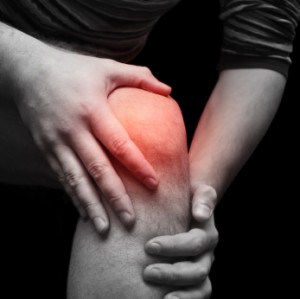
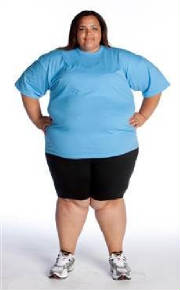
1. Bearing too much weight on the joints.
One of the main reasons people have knee
problems is they place too much weight on the knee joints. This is most common in overweight people. The knee joint holds
most of the weight of the body so the more a person weights the more stress they place on their knee joints. For every pound
a person is overweight, they add an extra 5-10 pounds of pressure on their joints. The smaller framed a person is the more
added stress is placed on their joints. If you are carrying a lot of extra weight on your frame and your knees constantly
hurt. Try shedding a few pounds.
2. Don’t be a weak ass (literally).
What most people don’t know is the
glutes play a major role in knee stability. Certain types of knee pains like tendonitis have a direct relationship with the
Gluteus Medius. The Gluteus Medius originates in the same spot as the other glute muscles but attaches to the side of the
leg. The Gluteus Medius helps with abduction (moving away from the body) of the leg. The Gluteus Medius also plays another
important role, it helps control leg stability. When the Gluteus Medius does not fire properly or is weak, it can cause leg
instability. When this happens the supports of the knee are forced to do the stability work instead of the glutes. This can
result in pain in or under the kneecaps. The key here is to focus on some exercises or movements that specifically target
the glutes. Exercises like glute bridges, step ups, and glute kickbacks should be a regular part of your exercise regiment.
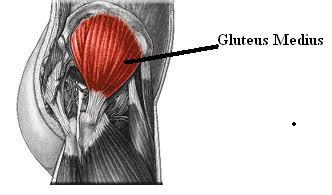 3. Can’t move the hip.
This is similar to number two but this
time it is related to the hips. When the hips are not stabilized properly the hips cannot rotate properly. Weak hip stability
forces the thighs inward. This forces more direct pressure on the knees resulting in pain. The goal in this instance is to
develop stronger and more flexible hips. Strengthening and flexibility exercises like abductions, single leg vertical leg
presses, and hip flexor stretching should be regularly used.
4. Hamstrings are too tight and weak.
Tight hamstrings can wreak havoc of the
back, hips, and yes you guessed it…the knees. One of the most serious risk factors for ACL (anterior cruciate ligament)
injuries and other various knee problems is weak or tight hamstrings. A majority of ACL pains and injuries are due to an inbalance
between quadriceps and hamstring muscle strength. When hamstrings are tight this balance gets thrown off even more. The result
is more stress being placed on the anterior knee structures.
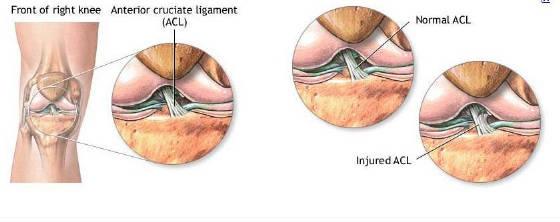
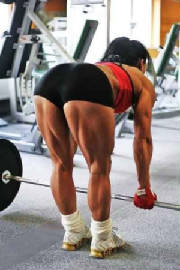
To help with this problem a person should focus on strengthening and stretching
the hamstring muscles thru closed chain exercises. Closed chain exercises mean the hands or feet are in constant contact with
a surface. Closed chain exercises also do a better job at opening up the hips and stretching the glutes and hamstrings. Exercise
like Stiff Leg Deadlifts, Glute Ham Raisers, and Romainin Deadlifts are great choices. In contrast, exercise like leg curls
will not work because they don’t require the glutes and hamstrings to contract and stretch at the same time.
5. Have “Cows” not calves.
Another reason for knee pain may be the
need for calf strengthening.Yes I did say calf muscles. The calves are made up of two major muscles. Those two muscles are
the gastrocnemius and the soleus. The gastrocnemius is the particular muscle to focus in on because it is the calf muscle
that crosses the knee. When calves are tight or weak, stressed is placed on the posterior part of the knee where the calf
muscle crosses. To focus on the gastrocnemuis you should incorporate exercises like Standing Calf Raisers, Donkey Calf Raisers
and lots of calf stretching.
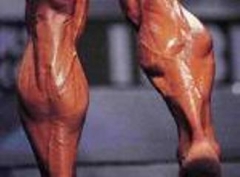
6. Too much of a good thing.
Ever hear the saying “Too much of
a good thing!” One problem may be just using the knees way too much. If any type of tendonitis in the knees is present,
take a good objectionable look at the training program being used.
One misconception is that the patella only
moves in a vertical manner. In actuality though, it also tilts and rotates. This means there are a lot more points of contact
between the undersurface of the patella and fermur. This possible repetitive rubbing and contact can be a big factor in tendonitis.
The key here is evaluating what training methods are being used and how they are affecting knee mobility and stability.
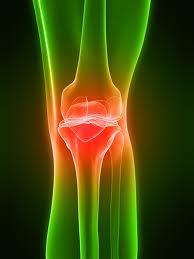
Wrapping up the knees-
Having constant knee pain can have a real
negative effect on everyday life. Constantly dealing with pain and not knowing why can be even worst. Everyday people suffer
from knee pain and some are do not understand why. While all knee pain can’t be simply diagnosed, understanding some
reasons for knee pain may be simpler than thought. While the actual pain may be in the knees, it may be signs of other issues
going on. Knee pains can be signs of being overweight, weak muscle, tight muscles, muscle imbalances, or just doing too much.
By taking a closer look at other areas that affect the knees, this may lead to a closer insight of a person’s knee aches.
*Disclaimer- This information in this article is not meant to treat, diagnose, prescribe or cure any ailment.
Always consult a physician before you begin any new exercise program, start, stop, or change anything that has been previously
prescribed...
Want a better understanding about rehab. Learn about various methods, programs, and injury related issues here.
In this section you can find articles about
- injuries
- rehab programs
- post rehab exercise programs
- preventive exercises
All articles on this site are authored or co-authored by Jarueba Taylor. They are the copy written
property of Taylored Nutrition.
|

